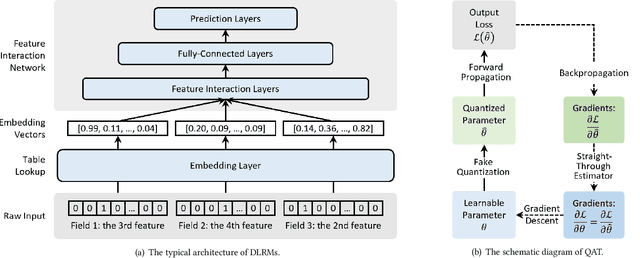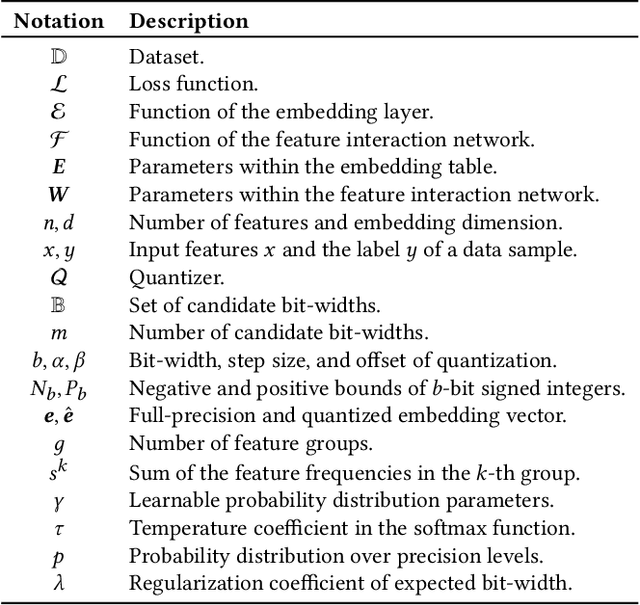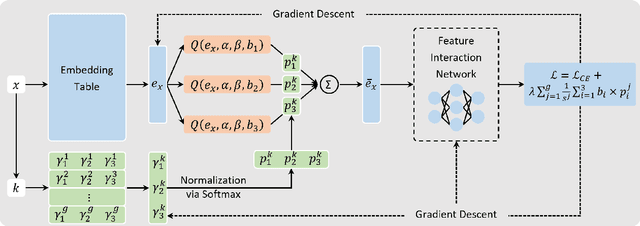Yuhua Li
BoRA: Towards More Expressive Low-Rank Adaptation with Block Diversity
Aug 09, 2025Abstract:Low-rank adaptation (LoRA) is a parameter-efficient fine-tuning (PEFT) method widely used in large language models (LLMs). It approximates the update of a pretrained weight matrix $W\in\mathbb{R}^{m\times n}$ by the product of two low-rank matrices, $BA$, where $A \in\mathbb{R}^{r\times n}$ and $B\in\mathbb{R}^{m\times r} (r\ll\min\{m,n\})$. Increasing the dimension $r$ can raise the rank of LoRA weights (i.e., $BA$), which typically improves fine-tuning performance but also significantly increases the number of trainable parameters. In this paper, we propose Block Diversified Low-Rank Adaptation (BoRA), which improves the rank of LoRA weights with a small number of additional parameters. Specifically, BoRA treats the product $BA$ as a block matrix multiplication, where $A$ and $B$ are partitioned into $b$ blocks along the columns and rows, respectively (i.e., $A=[A_1,\dots,A_b]$ and $B=[B_1,\dots,B_b]^\top$). Consequently, the product $BA$ becomes the concatenation of the block products $B_iA_j$ for $i,j\in[b]$. To enhance the diversity of different block products, BoRA introduces a unique diagonal matrix $\Sigma_{i,j} \in \mathbb{R}^{r\times r}$ for each block multiplication, resulting in $B_i \Sigma_{i,j} A_j$. By leveraging these block-wise diagonal matrices, BoRA increases the rank of LoRA weights by a factor of $b$ while only requiring $b^2r$ additional parameters. Extensive experiments across multiple datasets and models demonstrate the superiority of BoRA, and ablation studies further validate its scalability.
Adapter Naturally Serves as Decoupler for Cross-Domain Few-Shot Semantic Segmentation
Jun 09, 2025Abstract:Cross-domain few-shot segmentation (CD-FSS) is proposed to pre-train the model on a source-domain dataset with sufficient samples, and then transfer the model to target-domain datasets where only a few samples are available for efficient fine-tuning. There are majorly two challenges in this task: (1) the domain gap and (2) fine-tuning with scarce data. To solve these challenges, we revisit the adapter-based methods, and discover an intriguing insight not explored in previous works: the adapter not only helps the fine-tuning of downstream tasks but also naturally serves as a domain information decoupler. Then, we delve into this finding for an interpretation, and find the model's inherent structure could lead to a natural decoupling of domain information. Building upon this insight, we propose the Domain Feature Navigator (DFN), which is a structure-based decoupler instead of loss-based ones like current works, to capture domain-specific information, thereby directing the model's attention towards domain-agnostic knowledge. Moreover, to prevent the potential excessive overfitting of DFN during the source-domain training, we further design the SAM-SVN method to constrain DFN from learning sample-specific knowledge. On target domains, we freeze the model and fine-tune the DFN to learn target-specific knowledge specific. Extensive experiments demonstrate that our method surpasses the state-of-the-art method in CD-FSS significantly by 2.69% and 4.68% MIoU in 1-shot and 5-shot scenarios, respectively.
The Panaceas for Improving Low-Rank Decomposition in Communication-Efficient Federated Learning
May 29, 2025Abstract:To improve the training efficiency of federated learning (FL), previous research has employed low-rank decomposition techniques to reduce communication overhead. In this paper, we seek to enhance the performance of these low-rank decomposition methods. Specifically, we focus on three key issues related to decomposition in FL: what to decompose, how to decompose, and how to aggregate. Subsequently, we introduce three novel techniques: Model Update Decomposition (MUD), Block-wise Kronecker Decomposition (BKD), and Aggregation-Aware Decomposition (AAD), each targeting a specific issue. These techniques are complementary and can be applied simultaneously to achieve optimal performance. Additionally, we provide a rigorous theoretical analysis to ensure the convergence of the proposed MUD. Extensive experimental results show that our approach achieves faster convergence and superior accuracy compared to relevant baseline methods. The code is available at https://github.com/Leopold1423/fedmud-icml25.
Beyond Zero Initialization: Investigating the Impact of Non-Zero Initialization on LoRA Fine-Tuning Dynamics
May 29, 2025Abstract:Low-rank adaptation (LoRA) is a widely used parameter-efficient fine-tuning method. In standard LoRA layers, one of the matrices, $A$ or $B$, is initialized to zero, ensuring that fine-tuning starts from the pretrained model. However, there is no theoretical support for this practice. In this paper, we investigate the impact of non-zero initialization on LoRA's fine-tuning dynamics from an infinite-width perspective. Our analysis reveals that, compared to zero initialization, simultaneously initializing $A$ and $B$ to non-zero values improves LoRA's robustness to suboptimal learning rates, particularly smaller ones. Further analysis indicates that although the non-zero initialization of $AB$ introduces random noise into the pretrained weight, it generally does not affect fine-tuning performance. In other words, fine-tuning does not need to strictly start from the pretrained model. The validity of our findings is confirmed through extensive experiments across various models and datasets. The code is available at https://github.com/Leopold1423/non_zero_lora-icml25.
FlowCut: Rethinking Redundancy via Information Flow for Efficient Vision-Language Models
May 26, 2025Abstract:Large vision-language models (LVLMs) excel at multimodal understanding but suffer from high computational costs due to redundant vision tokens. Existing pruning methods typically rely on single-layer attention scores to rank and prune redundant visual tokens to solve this inefficiency. However, as the interaction between tokens and layers is complicated, this raises a basic question: Is such a simple single-layer criterion sufficient to identify redundancy? To answer this question, we rethink the emergence of redundant visual tokens from a fundamental perspective: information flow, which models the interaction between tokens and layers by capturing how information moves between tokens across layers. We find (1) the CLS token acts as an information relay, which can simplify the complicated flow analysis; (2) the redundancy emerges progressively and dynamically via layer-wise attention concentration; and (3) relying solely on attention scores from single layers can lead to contradictory redundancy identification. Based on this, we propose FlowCut, an information-flow-aware pruning framework, mitigating the insufficiency of the current criterion for identifying redundant tokens and better aligning with the model's inherent behaviors. Extensive experiments show that FlowCut achieves superior results, outperforming SoTA by 1.6% on LLaVA-1.5-7B with 88.9% token reduction, and by 4.3% on LLaVA-NeXT-7B with 94.4% reduction, delivering 3.2x speed-up in the prefilling stage. Our code is available at https://github.com/TungChintao/FlowCut
The Devil is in Low-Level Features for Cross-Domain Few-Shot Segmentation
Mar 27, 2025Abstract:Cross-Domain Few-Shot Segmentation (CDFSS) is proposed to transfer the pixel-level segmentation capabilities learned from large-scale source-domain datasets to downstream target-domain datasets, with only a few annotated images per class. In this paper, we focus on a well-observed but unresolved phenomenon in CDFSS: for target domains, particularly those distant from the source domain, segmentation performance peaks at the very early epochs, and declines sharply as the source-domain training proceeds. We delve into this phenomenon for an interpretation: low-level features are vulnerable to domain shifts, leading to sharper loss landscapes during the source-domain training, which is the devil of CDFSS. Based on this phenomenon and interpretation, we further propose a method that includes two plug-and-play modules: one to flatten the loss landscapes for low-level features during source-domain training as a novel sharpness-aware minimization method, and the other to directly supplement target-domain information to the model during target-domain testing by low-level-based calibration. Extensive experiments on four target datasets validate our rationale and demonstrate that our method surpasses the state-of-the-art method in CDFSS signifcantly by 3.71% and 5.34% average MIoU in 1-shot and 5-shot scenarios, respectively.
Migician: Revealing the Magic of Free-Form Multi-Image Grounding in Multimodal Large Language Models
Jan 13, 2025



Abstract:The recent advancement of Multimodal Large Language Models (MLLMs) has significantly improved their fine-grained perception of single images and general comprehension across multiple images. However, existing MLLMs still face challenges in achieving precise grounding in complex multi-image scenarios. To address this, we first explore a Chain-of-Thought (CoT) framework that integrates single-image grounding with multi-image comprehension. While partially effective, it remains unstable and struggles to capture abstract visual information due to its non-end-to-end nature. Therefore, we introduce Migician, the first multi-image grounding model capable of performing free-form and accurate grounding across multiple images. To support this, we present the MGrounding-630k dataset, which comprises data for several multi-image grounding tasks derived from existing datasets, along with newly generated free-form grounding instruction-following data. Furthermore, we propose MIG-Bench, a comprehensive benchmark specifically designed for evaluating multi-image grounding capabilities. Experimental results demonstrate that our model achieves significantly superior multi-image grounding capabilities, outperforming the best existing MLLMs by 21.61% and even surpassing much larger 70B models. Our code, model, dataset, and benchmark are fully open-sourced at https://migician-vg.github.io/.
Reconstruction Target Matters in Masked Image Modeling for Cross-Domain Few-Shot Learning
Dec 26, 2024



Abstract:Cross-Domain Few-Shot Learning (CDFSL) requires the model to transfer knowledge from the data-abundant source domain to data-scarce target domains for fast adaptation, where the large domain gap makes CDFSL a challenging problem. Masked Autoencoder (MAE) excels in effectively using unlabeled data and learning image's global structures, enhancing model generalization and robustness. However, in the CDFSL task with significant domain shifts, we find MAE even shows lower performance than the baseline supervised models. In this paper, we first delve into this phenomenon for an interpretation. We find that MAE tends to focus on low-level domain information during reconstructing pixels while changing the reconstruction target to token features could mitigate this problem. However, not all features are beneficial, as we then find reconstructing high-level features can hardly improve the model's transferability, indicating a trade-off between filtering domain information and preserving the image's global structure. In all, the reconstruction target matters for the CDFSL task. Based on the above findings and interpretations, we further propose Domain-Agnostic Masked Image Modeling (DAMIM) for the CDFSL task. DAMIM includes an Aggregated Feature Reconstruction module to automatically aggregate features for reconstruction, with balanced learning of domain-agnostic information and images' global structure, and a Lightweight Decoder module to further benefit the encoder's generalizability. Experiments on four CDFSL datasets demonstrate that our method achieves state-of-the-art performance.
Lightweight Frequency Masker for Cross-Domain Few-Shot Semantic Segmentation
Oct 29, 2024



Abstract:Cross-domain few-shot segmentation (CD-FSS) is proposed to first pre-train the model on a large-scale source-domain dataset, and then transfer the model to data-scarce target-domain datasets for pixel-level segmentation. The significant domain gap between the source and target datasets leads to a sharp decline in the performance of existing few-shot segmentation (FSS) methods in cross-domain scenarios. In this work, we discover an intriguing phenomenon: simply filtering different frequency components for target domains can lead to a significant performance improvement, sometimes even as high as 14% mIoU. Then, we delve into this phenomenon for an interpretation, and find such improvements stem from the reduced inter-channel correlation in feature maps, which benefits CD-FSS with enhanced robustness against domain gaps and larger activated regions for segmentation. Based on this, we propose a lightweight frequency masker, which further reduces channel correlations by an amplitude-phase-masker (APM) module and an Adaptive Channel Phase Attention (ACPA) module. Notably, APM introduces only 0.01% additional parameters but improves the average performance by over 10%, and ACPA imports only 2.5% parameters but further improves the performance by over 1.5%, which significantly surpasses the state-of-the-art CD-FSS methods.
Mixed-Precision Embeddings for Large-Scale Recommendation Models
Sep 30, 2024



Abstract:Embedding techniques have become essential components of large databases in the deep learning era. By encoding discrete entities, such as words, items, or graph nodes, into continuous vector spaces, embeddings facilitate more efficient storage, retrieval, and processing in large databases. Especially in the domain of recommender systems, millions of categorical features are encoded as unique embedding vectors, which facilitates the modeling of similarities and interactions among features. However, numerous embedding vectors can result in significant storage overhead. In this paper, we aim to compress the embedding table through quantization techniques. Given that features vary in importance levels, we seek to identify an appropriate precision for each feature to balance model accuracy and memory usage. To this end, we propose a novel embedding compression method, termed Mixed-Precision Embeddings (MPE). Specifically, to reduce the size of the search space, we first group features by frequency and then search precision for each feature group. MPE further learns the probability distribution over precision levels for each feature group, which can be used to identify the most suitable precision with a specially designed sampling strategy. Extensive experiments on three public datasets demonstrate that MPE significantly outperforms existing embedding compression methods. Remarkably, MPE achieves about 200x compression on the Criteo dataset without comprising the prediction accuracy.
 Add to Chrome
Add to Chrome Add to Firefox
Add to Firefox Add to Edge
Add to Edge